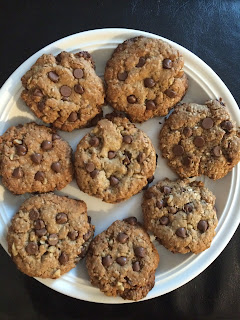Blueberry Breakfast Cake
This week, as I was looking through my dessert board on Pinterest I decided that I would make a blueberry breakfast cake for my Genius Hour project. This cake is a step up in difficulty from the oatmeal chocolate chip cookies I made in my first week. This cake is also unlike any other I have made before, as it has more of a coffee cake consistency. I was excited to make this cake because the idea of blueberry and lemon flavours together sounded delicious! I was also excited to have something I could easily grab on my way out the door as a snack for the days when I am at school for long periods of time.
Fell free to check out the original
recipe I used to make my blueberry breakfast cake!
Ingredients:
1/2 cup unsalted butter at room temperature
Zest from 1 lemon
3/4 cup granulated sugar
1 large egg at room temperature
1 teaspoon pure vanilla extract
2 cups all-purpose flour
2 teaspoons baking powder
1/2 teaspoon sea salt
2 cups fresh blueberries
1/2 cup buttermilk
1 teaspoon turbinado sugar for sprinkling
Instructions:
1. Preheat the oven to 325 degrees.
2. Grease and lightly flour a springform pan.
3. In a mixing bowl: combine the flour, salt, and baking powder.
4. Remove 2 tablespoons of the flour mixture and set aside.
5. In another mixing bowl combine the butter, lemon zest, and granulated sugar. Beat this mixture for several minutes until it is light and fluffy. Scrape down the sides as needed.
6. Beat the egg and vanilla into the butter mixture until incorporated.
7. Add 1/3 of the flour mixture to the butter mixture. Beat on low until incorporated. Add 1/3 of the buttermilk and blend until smooth. Repeat these steps adding 1/3 of the flour mixture then 1/3 of the buttermilk until both are combined.
8. Toss the blueberries in the 2 tablespoons of flour that had been set aside.
9. Using a rubber spatula, gently fold the blueberries into the batter. Make sure you do not rupture the blueberries!

10. Scoop the batter into the springform pan and spread evenly. Sprinkle the top with the turbinado sugar.
11. Bake for 40-45 minutes, until the top is lightly browned.
Results:
Waiting for that cake to bake definitely tested my patients as our house filled with a fresh and citrusey aroma! I can tell you though...it was well worth the wait!! When I took the cake out of the oven, I was pleased to see that it looked very similar to the picture in the recipe I had used. The cake was a light golden brown with blueberries dotted throughout. I was also happy that the cake slid off the base of the springform pan easily, as I was worried it may break in the process.
After the cake had cooled we were finally able to try a piece, it was DELICIOUS! The texture was just like coffee cake with the top being perfectly crisp and the inside moist and fluffy. Also, the combination of the blueberries and the lemon zest made the cake taste fresh and light. I feel very proud of this cake as it is probably the most successful attempt at baking I have ever had. My taste-testers also agreed that this cake was absolutely delicious, and helped themselves to seconds. I am adding this recipe to my box as I know I will make it again in the future. The only addition I would make to this recipe next time, would be to sprinkle more turbinado sugar on the cake as it helped to make the top crisp and sweet.

Overall, week 2 of my Genius Hour project was a great success! I am realizing throughout this experience that I actually enjoy baking much more than I had originally thought. I am also starting to gain more confidence in my baking skills as I realize that not only am I enjoying the process, but my failed attempts in the past have not been repeated thus far! I am excited to see where the next couple of weeks lead me with my project.



















